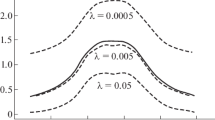The narcissus constant, N = 2.3983843828..., is defined as a number that fulfills the narcissistic infinite nested radical equation
Incorporation of this constant, its square and its cube into the generalized version of the Lennard-Jones potential function gives the narcissus constant potential function
which (a) is suitable for modeling van der Waals interaction due to its agreement with the Lennard-Jones (12-6) potential energy curve over long range, and (b) forms simple generalized hybrid interatomic–intermolecular potential energy function due to its correlation with the averaged form of Lennard-Jones, Morse, Buckingham and Linnett potential energy curve near the minimum well-depth.
Similar content being viewed by others
References
T.C. Lim, On the applicability of mathematical constants and sequences in intermolecular potential energy functions, J. Math. Chem. (in press).
T.C. Lim, Combination of pi and golden ratio in Lennard–Jones-type and Morse-type potential energy functions, J. Math. Chem. (in press).
Vieta F. (1970) Uriorum De Rebus Mathematicis Responsorum. Georg Olms, New York, pp. 398–446
Wells D. (1986) The Penguin Dictionary of Curious and Interesting Numbers. Penguin Books, Middlesex, p. 50
Beckmann P. (1989) A History of Pi, 3rd ed. Dorset Press, New York, p. 95
Livio M. (2002) The Golden Ratio: The Story of Pi, the World’s Most Astonishing Number. Broadway Books, New York, p. 83
Stewart I. (1996) Tales of a neglected number, Sci. Am. 274:102–103
J. Aarts, R.J. Fokkink and G. Kruijtzer, Morphic Numbers, Nieuw Archief voor Wiskunde 5th Ser 2 (2001) 56–58.
F. Le Lionnais, Les Nombres Remarquables (Hermann, Paris, 1983) pp. 51 and 143.
Saaty T.L., Kainen P.C. (1986) The Four-Color Problem : Assaults and Conquest. Dover, New York, p. 162
Lim T.C. (2005) A functionally flexible interatomic energy function based on classical potentials. Chem. Phys. 320:54–58
Lennard-Jones J.E. (1924) On the determination of molecular fields. II. From the equation of state of a gas. Proc. R. Soc. Lond. A 106:463–477
Mecke R. (1927) Bandenspektra und periodisches system der elemente. Zeit. Physik 42:390–425
G.B.B.M. Sutherland, The relation between the force constant, the inter-nuclear distance, and the dissociation energy of a diatomic linkage, Proc. Indian Acad. Sci. 8 (1938) 341–344.
Morse P.M. (1929) Diatomic molecules according to the wave mechanics. II. Vibrational levels. Phys. Rev. 34:57–64
Buckingham R.A. (1938) The classical equation of gaseous helium, neon and argon. Proc. R. Soc. Lond. A 168:264–283
Wu C.K., Yang C.T. (1944) The relation between the force constant and the interatomic distance of a diatomic linkage. J. Phys. Chem. 48:295–303
Linnett J.W. (1940) The relation between potential energy and interatomic distance in some diatomic molecules. Trans. Faraday Soc. 36:1123–1134
Linnett J.W. (1942) The relation between potential energy and interatomic distance in some diatomic molecules II. Trans. Faraday Soc. 38, 1–9
R. Levi, R. Roundy and D.B. Shmoys, A constant approximation algorithm for the one-warehouse multi-retailer problem, in: Proceedings of the 16th Annual ACM-SIAM Symposium on Discrete Algorithms, Session 4C (Vancouver, Washington, DC, 2005) pp. 365–374.
Author information
Authors and Affiliations
Corresponding author
Rights and permissions
About this article
Cite this article
Lim, TC. Potential energy function based on the narcissus constant, its square and its cube. J Math Chem 43, 304–313 (2008). https://doi.org/10.1007/s10910-006-9196-4
Published:
Issue Date:
DOI: https://doi.org/10.1007/s10910-006-9196-4




